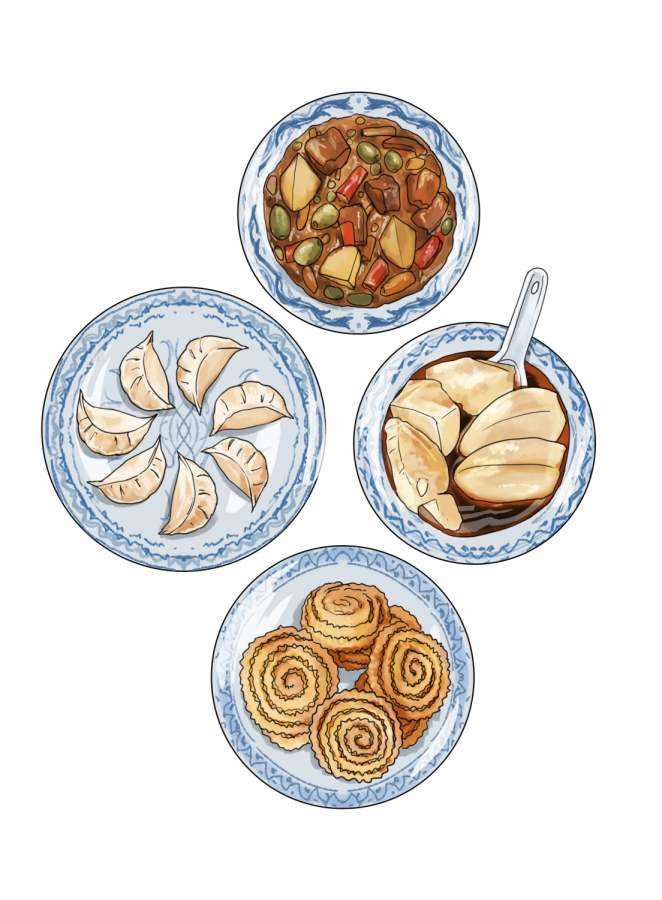Asian American communities connect to culture, express love through food
May 5, 2022
As a child, Jennifer Ling Datchuk routinely helped her grandmother prepare a fresh batch of dumplings. With her grandmother’s homemade wrappers in hand, she placed a spoonful of filling and painstakingly pinched them shut.
Nourishing their bond through food, Datchuk said her grandmother would always remember her favorite dessert, tau fu fah, a Chinese silken tofu pudding.
“Every time we went to dimsum, the first thing (my grandmother) would ask for was, ‘I want one (tau fu fah) for Jennifer,’” said Datchuk, an assistant professor at Texas State University’s School of Art and Design. “That was her way of showing love. That’s a really special relationship — very few people know your true favorite (food).”
Datchuk said the techniques she learned from making Chinese dishes translates into the ceramics she creates. The artist curated an ongoing exhibit at Austin’s Asian American Resource Center called “Sweet and Sour,” exploring Asian Americans’ shared experiences of using food to express their love and care, coming to terms with their cultural identity and conveying their wishes to hear words of affirmation from their parents.
Taking inspiration from “Eat Drink Man Woman” — a film by Ang Lee that shows a chef cooking elaborate Chinese meals for his daughters — Datchuk said she prompted Asian American ceramists to think about the scene at their own dinner tables while crafting their pieces for the exhibit.
“So much of my tongue was connected to those flavors that (they’re) deeply stored in my body,” Datchuk said. “I think about that longing and sense of connection through our tongues — especially our mother tongues — when we sit at that table and speak to each other.”
Emphasizing the value of sustenance in Asian cuisine, Alice McCoy-Bae, UT assistant professor of instruction, said the labor-intensive and collaborative nature of Asian food preparation transpired from early agriculture-based societies that practiced barter trade. McCoy-Bae said that many foods in South Korea use fermentation, a natural process that changes a food’s properties with microorganisms, to preserve meals for a longer time and improve their nutritional content.
“(It takes) many days (with the) effort and time you put (into preparation while) thinking about your loved ones,” McCoy-Bae said. “The fermentation process (is) very symbolic. We wait patiently and make it just right to provide wonderful food.”
As a parent, McCoy-Bae prepares various Korean dishes, such as japchae, or stir-fried glass noodles, for her daughter to bring to college. McCoy-Bae said eating family-made traditional food evokes pleasant memories of childhood and being cared for.
“I don’t think it’s just about how delicious (the food) is,” McCoy-Bae said. “It’s more (about) the memory (of) family members getting together and sharing this moment which cannot be replicated. … I hope my daughter remembers me that way through food.”
After seeing his mother’s smile when he cooked breakfast for her on Mother’s Day, Lance Bolastig began putting dishes together for his family and friends. Bolastig said he noticed how his parents celebrated him and his siblings’ achievements by preparing special meals or buying treats for them.
“Every social event has food at the center of it,” said Bolastig, a medical laboratory science freshman. “(Food) would always be something you’d share and bond over.”
Bolastig said each family member has their own distinct, intrinsic way of making a dish, typically without exact measurements for ingredients and time. He said he vividly recalls eating his grandfather’s kaldereta, a Filipino meat stew with vegetables and liver paste in tomato sauce, and it is a taste of the Philippines that he carries with him.
“Everyone’s like, ‘No one can match how well he (cooks kaldereta),’” Bolastig said. “(My grandfather) tries to train my uncle to make it, but he can never get it right. … My grandfather’s kaldereta is just so unique and probably my favorite dish.”
Although his household seldom expresses their emotions, Timothy Chacko finds himself mirroring the way his family cooks to connect with his Indian heritage. He said he enjoys reminiscing about frying his grandmother’s spiral-shaped snack, murukku, and preparing traditional cuisine with vegetables from his grandparents’ garden — a space where they’ve cultivated Indian-grown crops for decades since coming to the United States.
Instead of using words, Chacko said his parents usually communicate their fondness for him by serving food.
“Cutting up fruit is one thing my parents would always do,” the finance junior said. “(They’ll bring) cut-up mangoes, bananas, apples. … They’re not gonna say ‘I love you,’ but thy’re gonna give (me) a bowl of fruit.”
Because of his lifelong exposure to food, Chacko said he uses cooking as a form of creative expression. Chacko said he feels most at home when he and his family gather around and eat the large spread of meals they’ve cooked together.
“Across the Asian diaspora, food is one of the most important means of getting back to your culture,” Chacko said. “(Food) is the one thing (others) can’t take away from us. It’s something you’re so familiar with growing up. … It always reminds you of back home.”



